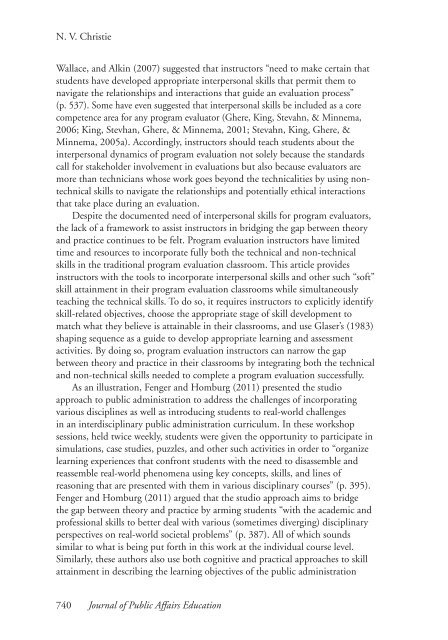An Interpersonal Skills Learning Taxonomy for Program Evaluation ...
An Interpersonal Skills Learning Taxonomy for Program Evaluation ...
An Interpersonal Skills Learning Taxonomy for Program Evaluation ...
Create successful ePaper yourself
Turn your PDF publications into a flip-book with our unique Google optimized e-Paper software.
N. V. ChristieWallace, and Alkin (2007) suggested that instructors “need to make certain thatstudents have developed appropriate interpersonal skills that permit them tonavigate the relationships and interactions that guide an evaluation process”(p. 537). Some have even suggested that interpersonal skills be included as a corecompetence area <strong>for</strong> any program evaluator (Ghere, King, Stevahn, & Minnema,2006; King, Stevhan, Ghere, & Minnema, 2001; Stevahn, King, Ghere, &Minnema, 2005a). Accordingly, instructors should teach students about theinterpersonal dynamics of program evaluation not solely because the standardscall <strong>for</strong> stakeholder involvement in evaluations but also because evaluators aremore than technicians whose work goes beyond the technicalities by using nontechnicalskills to navigate the relationships and potentially ethical interactionsthat take place during an evaluation.Despite the documented need of interpersonal skills <strong>for</strong> program evaluators,the lack of a framework to assist instructors in bridging the gap between theoryand practice continues to be felt. <strong>Program</strong> evaluation instructors have limitedtime and resources to incorporate fully both the technical and non-technicalskills in the traditional program evaluation classroom. This article providesinstructors with the tools to incorporate interpersonal skills and other such “soft”skill attainment in their program evaluation classrooms while simultaneouslyteaching the technical skills. To do so, it requires instructors to explicitly identifyskill-related objectives, choose the appropriate stage of skill development tomatch what they believe is attainable in their classrooms, and use Glaser’s (1983)shaping sequence as a guide to develop appropriate learning and assessmentactivities. By doing so, program evaluation instructors can narrow the gapbetween theory and practice in their classrooms by integrating both the technicaland non-technical skills needed to complete a program evaluation successfully.As an illustration, Fenger and Homburg (2011) presented the studioapproach to public administration to address the challenges of incorporatingvarious disciplines as well as introducing students to real-world challengesin an interdisciplinary public administration curriculum. In these workshopsessions, held twice weekly, students were given the opportunity to participate insimulations, case studies, puzzles, and other such activities in order to “organizelearning experiences that confront students with the need to disassemble andreassemble real-world phenomena using key concepts, skills, and lines ofreasoning that are presented with them in various disciplinary courses” (p. 395).Fenger and Homburg (2011) argued that the studio approach aims to bridgethe gap between theory and practice by arming students “with the academic andprofessional skills to better deal with various (sometimes diverging) disciplinaryperspectives on real-world societal problems” (p. 387). All of which soundssimilar to what is being put <strong>for</strong>th in this work at the individual course level.Similarly, these authors also use both cognitive and practical approaches to skillattainment in describing the learning objectives of the public administration740 Journal of Public Affairs Education
















